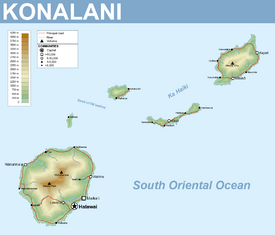Konalani
Kingdom of Konalani | |
|---|---|
| Motto: Lanakila ʻana "To victory" | |
| Anthem: Mele o Konalani Song of Konalani | |
 Map of Konalani | |
| Capital and largest city | Halawai |
| Official languages | Konalanese ColonialGroup1 Language Oharic |
| Recognised regional languages | LabourGroup1 Language Esonian |
| Ethnic groups (2020) | 37.1% Konalanese 28.7% LabourGroup1 11.2% ColonialGroup1 10.2% Orinese 9.8% Esonian 2.9% Other |
| Religion (2020) | WIP |
| Demonym(s) | Konalanese |
| Government | Federal parliamentary constitutional monarchy |
• Monarch | Lokelani |
| Kale Alika | |
| Legislature | Parliament |
| House of Nobles | |
| Assembly | |
| Establishment | |
| 10 March 1822 | |
| Area | |
• Total | 824 km2 (318 sq mi) |
• Water (%) | 5.5 |
| Population | |
• 2020 census | 121,480 |
• Density | 147/km2 (380.7/sq mi) |
| GDP (PPP) | 2023 estimate |
• Total | $10.85 billion |
• Per capita | $89,315 |
| GDP (nominal) | 2023 estimate |
• Total | $7.50 billion |
• Per capita | $61,775 |
| Gini (2023) | high |
| Currency | Kālā (Ꝃ) (KKL) |
| Time zone | UTC−12 (Burkini–Konalani Time Zone) |
| Driving side | right |
| Calling code | +612 |
| ISO 3166 code | KO |
| Internet TLD | .ko |
Konalani, officially the Kingdom of Konalani (Konalanese: Aupuni o Konalani), is an island country in the South Oriental Ocean of Thalassa. The country is made up of five islands in an archipelago, and has a total size of 824 km². With a population of 121,480 as of 2020, it is the 119th smallest country by population in the wurld, with over 72% of the population residing on the largest island, Mokunui. Konalani's closest neighbours are the Sunset Sea Islands to the northeast and Burkini to the north.
Konalani is attested to have been inhabited between the 6th and 11th centuries by Azano-Marenesian peoples originating from Burkini, Apuni, and other islands in the South Oriental, with these groups later forming the unified cultural traditions, language, and identity of the modern-day indigenous Konalanese. Organized into small proto-statelets for most of its history, the islands remained in relative isolation until the 18th century, when contact was made with [WIP] and [WIP] explorers, who quickly saw Konalani as a valuable tradeport and refueling station for ships between Thalassa and Marenesia. In response to increased contact with Thalassan and Marenesian navies, chief Kahikilani of the island of Nahoe began to consolidate power on the archipelago, and formed a proto-state centred around the fishing village of Kaala by the early 19th century. In 1822, after violent incursions between [WIP] and [WIP] expeditions, the Treaty of the Paddles ...

